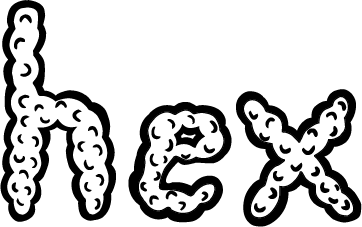My colleague mentions seeing between words. He says if he unfocuses his eyes he can worm his way through the empty network on the page, connecting the gaps, and, once connected, the spaces—or is it a single space, the entirety of a page?—stand out, together in relative isolation, jutting from the typeset, and there it is, an image: a thorny seahorse, suppose.
An optical illusion, or something like, and of what, I can’t be sure. I have no eyes for this, I say.
He, my colleague, says: your brain wants to find the pattern, and when it does, you will think, how did I not see it before?
As if a chain-link fence. I do the very thing: conjoin the points, though not all, as instructed, only connecting those at the largest openings, my brain trying to make something of shapes around letters, but it’s as though I am looking at a chain-link fence, webbed across my vision, my eyes wanting to go beyond, at what the fence holds in, at the sentences. I say: I see the opposite. The negative of what you say to see, only words.
We begin again, my colleague eager for me to do what he does. He explains it will be worth it and doesn’t want to stop just yet, not after a single attempt. This time he photocopies a page. He explains that it’s like looking up at the night sky and connecting stars. But in this case, starting with the largest opening and making a point, then finding another and another. From there, a sort of constellation will form. He adds dots in the gaps, some large, some not so large, but now that I look more closely, there are clearly areas that are much larger than those around it. After dots, lines, polygons, eventually, an image. On this page, he says, a two-headed snake. See?
Not really, no, I say.
Let’s keep going.
As he searches for a new page in a new book, us being in a place filled with books, he explains he is looking for the right page in the right book, an easy example, since I am new to this type of gazing, and it takes time, all of this coming from a lull, a gap where all we can do is wait for a patron to enter and inquire, all other tasks having been completed or having been sent off to others for review, and when they give their feedback we can get back to work, but until then or until there is a patron, there is a lull, and once he finds it, and makes copies, one for him to apply his constellation and one for me to do the same, but before all that, during the period while he sought and I waited, I mentioned canopy shyness, how the branches of certain trees will never touch those nearby. They will grow up and out and never collide, and so there is a perfect trail between them, a void where if you were to look up, you would see channels of light, of air, of clouds, of nothing. I wonder if you can do the same thing with those trees, see between them, and find an image: a leaf slug, say.
He ignores me, preoccupied with identifying the hidden shape before passing me my copy. I follow his process of dot, line, polygon, but the potential paths go on and on. I erase multiple sequences and start again. He assures me that if I keep it up, following his instruction by first locating the larger openings and then joining them, I will soon see how they fit together, their relationship into something I can easily recognize.
Through the trees, through the words, along the chain-link fence and not beyond, I allow the dots to point my way along the breaks, and then the lines come with a drag of my pencil along the paper, until I see. Yes, I can finally see. I show him what I see. I say: a dog, a wolf, a coyote.
Yes, he says excitedly, his eyes lighting up, full of stars, stars which quickly fade when he checks my work, tilts his head, finds we have found the identical beast, some type of canine, in an identical orientation, but in two independent instances; the same conclusion by the same means, but in different spaces: two dogs, two wolves, two coyotes, on the page, through the trees, in the night sky. It takes him a moment, his head full of confusion, needing to shift, reorganize in the initial excitement, in the lull.
His eyes come back, alight. Yes, he says again, truly happy and with something else, not embarrassment, not really, but he appears more self-conscious, less sure, and yet never more sure, when he reveals his prior confidence in the pattern, believing there to be only ever one, always, all this time, but I can see where he can’t, he explains, this is better, he reasons, unexpected but better, he rationalizes. Together, he says, we will see more; together we won’t miss a thing.
Turning back to the shelves, he grabs a book at random—no longer searching for the right page in the right book, perhaps convinced I no longer need it—and without copy or pencil, no dot or line, we try again; we try again until there is no lull, until there is only what we can see, what comes through.
________
Martin Piñol is a librarian. His work has appeared in 3:AM Magazine, About Place Journal, Asymptote, The Journal, The Los Angeles Review, The Maine Review, and is forthcoming in Hunger Mountain Review.
